So it was something of a surprise in re-reading The Man of Steel just how different the era of Crisis on Infinite Earths was. It makes series like Legends seem less stupid, though it did still suck and probably put me off of liking any of the New Gods and Darkseid stuff for good. Also a failing of Final Crisis, come to think of it.
The Man of Steel was the re-launch of Superman after Crisis. DC handed over Superman to John Byrne at this point, coming off his hot run on Uncanny X-Men and the Fantastic Four. With the end of this 6 issue limited series, Byrne would be writing both Superman and Action Comics, while Marv Wolfman got The Adventures of Superman. Pretty heavy hitting talent at that time, so this mini-series was a big deal to get that going. Unlike the ongoing series that he would only be writing, Byrne both wrote and pencilled The Man of Steel. Dick Giordano took care of the inks and Tom Ziuko did colors.
This series lived up to its billing as a new beginning. It started at square one and fleshed out Superman's first two to three years after the identity was created. While many new concepts were brought in, and a lot of the Superman baggage that had acumulated over the preceding 47 years was dropped or cleaned up, it still was beholden to the same Superman we'd known before crisis, whatever "Earth" he might have been from (with the exception of Ultraman).
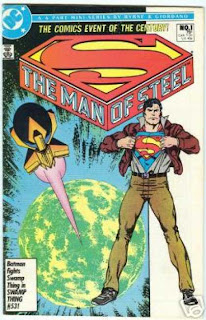
The first issue starts with Clark Kent as high school senior, reveling in his abilities and single handedly carrying his football team to victories. He's scolded by Pa Kent after the final game of the season and taken to the field where he was discovered by the Kents. He's told he's adopted and was found in a rocket ship. Clark takes his father's words to heart and travels around the world, helping people as he can with his abilities while staying anonymous. Ma Kent builds a scrapbook of his exploits. One day the greatful crowd presses in close after a rescue, and everyone wants something. Clark flees home to Smallville. Ma and Pa help him create the Superman identity. Oh, and the event with the pressing crowd was saving an experimental space plane on which Lois Lane was riding. In her story about it, she coins the name Superman.
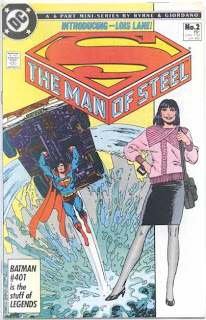 The second issue brings in more of Lois Lane. She's been spending months trying to get an exclusive interview with Superman, and has a crush on him. She fends off the attentions of businessman Lex Luther while also exploiting his affection in order to use his resources to try to track down Superman. Eventually she stages an accident and is rescued by Superman, who talks to her awhile afterward, doesn't give her a story that has much. All the same, she writes up what she gets and rushes to the Daily Planet, only to find she's been scooped by new hire Clark Kent. This sets the stage for the romantic comedy relationship between Lois and Clark. On a more minor note, he breaks an old superhero taboo and hits a woman. She's a bank robber who's taken hostages, but a woman all the same. A cute moment, as she pleads for him to not hit a lady, and Superman says she's not a lady. Very Henny Youngman.
The second issue brings in more of Lois Lane. She's been spending months trying to get an exclusive interview with Superman, and has a crush on him. She fends off the attentions of businessman Lex Luther while also exploiting his affection in order to use his resources to try to track down Superman. Eventually she stages an accident and is rescued by Superman, who talks to her awhile afterward, doesn't give her a story that has much. All the same, she writes up what she gets and rushes to the Daily Planet, only to find she's been scooped by new hire Clark Kent. This sets the stage for the romantic comedy relationship between Lois and Clark. On a more minor note, he breaks an old superhero taboo and hits a woman. She's a bank robber who's taken hostages, but a woman all the same. A cute moment, as she pleads for him to not hit a lady, and Superman says she's not a lady. Very Henny Youngman.Issue three introduces Superman's relationship with Batman. Superman's in Gotham to check 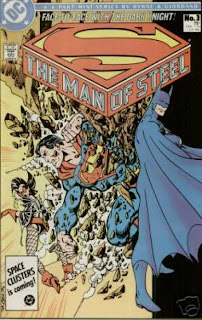 out the vigilante he's heard about and to take Batman into the police. Batman, being of no superpowers at all, establishes right off that he's better prepared and smarter than Superman, which isn't a new dynamic to their past relationship. Well, it is compared to pre-Crisis, but I always think of the Superman/Batman relationship through the lens of Frank Miller's The Dark Knight Returns. Anyway, Batman shows Superman that there's a force field around him set to detect Superman and if Superman penetrates the field, a bomb will explode and kill an innocent. Of course, we all know the bomb's on Batman. Where else would it be? He's a good guy, after all. This device allows Batman and Superman to work together to capture an entirely forgetable villain who's being created in an attempt to add to Batman's pantheon of villians. Magpie's an poor excuse for a villain and obviously didn't gain much traction as such. They do capture her rather easily, and and Batman reveals that he's the bomb victim. A detente is reached. Relationship established.
out the vigilante he's heard about and to take Batman into the police. Batman, being of no superpowers at all, establishes right off that he's better prepared and smarter than Superman, which isn't a new dynamic to their past relationship. Well, it is compared to pre-Crisis, but I always think of the Superman/Batman relationship through the lens of Frank Miller's The Dark Knight Returns. Anyway, Batman shows Superman that there's a force field around him set to detect Superman and if Superman penetrates the field, a bomb will explode and kill an innocent. Of course, we all know the bomb's on Batman. Where else would it be? He's a good guy, after all. This device allows Batman and Superman to work together to capture an entirely forgetable villain who's being created in an attempt to add to Batman's pantheon of villians. Magpie's an poor excuse for a villain and obviously didn't gain much traction as such. They do capture her rather easily, and and Batman reveals that he's the bomb victim. A detente is reached. Relationship established.
 out the vigilante he's heard about and to take Batman into the police. Batman, being of no superpowers at all, establishes right off that he's better prepared and smarter than Superman, which isn't a new dynamic to their past relationship. Well, it is compared to pre-Crisis, but I always think of the Superman/Batman relationship through the lens of Frank Miller's The Dark Knight Returns. Anyway, Batman shows Superman that there's a force field around him set to detect Superman and if Superman penetrates the field, a bomb will explode and kill an innocent. Of course, we all know the bomb's on Batman. Where else would it be? He's a good guy, after all. This device allows Batman and Superman to work together to capture an entirely forgetable villain who's being created in an attempt to add to Batman's pantheon of villians. Magpie's an poor excuse for a villain and obviously didn't gain much traction as such. They do capture her rather easily, and and Batman reveals that he's the bomb victim. A detente is reached. Relationship established.
out the vigilante he's heard about and to take Batman into the police. Batman, being of no superpowers at all, establishes right off that he's better prepared and smarter than Superman, which isn't a new dynamic to their past relationship. Well, it is compared to pre-Crisis, but I always think of the Superman/Batman relationship through the lens of Frank Miller's The Dark Knight Returns. Anyway, Batman shows Superman that there's a force field around him set to detect Superman and if Superman penetrates the field, a bomb will explode and kill an innocent. Of course, we all know the bomb's on Batman. Where else would it be? He's a good guy, after all. This device allows Batman and Superman to work together to capture an entirely forgetable villain who's being created in an attempt to add to Batman's pantheon of villians. Magpie's an poor excuse for a villain and obviously didn't gain much traction as such. They do capture her rather easily, and and Batman reveals that he's the bomb victim. A detente is reached. Relationship established.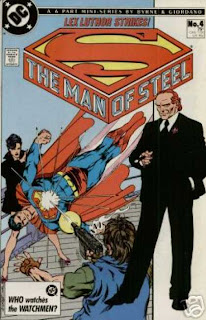
Perhaps the most notable change comes in the fourth issue. Lex Luthor has already been mentioned as a businessman and the most powerful man in Metropolis, but this issue brings him to the fore. It's about 18 months since Superman came out of the closet, so to speak, and Lex throws a party on a very large yacht. The event is being covered by Lois and Clark. Lex is really using it to draw some terrorists from South America to attack him, which in turn will lead to Superman saving the day. That part of the plot works, and we get some titilation with Lois taking off the dress Lex gave her under false pretenses and finishing out the rest of the issue in naught but Clark's tux jacket, oversized though it is on her. What doesn't work is Lex trying to put Superman on retainer as an employee. Lex ends up arrested for endangerment because he had a strong suspicion the attack would occur and didn't try to stop it. A nice touch in this segment is the apparent death of Clark at the hands of the terrorists and the later Superman statement that he saved Clark. A nice nod to the myriad variations on that theme that were used in the prior 47 years.
Ostensibly issue five is about Bizarro, but really it's an extension of the fued with Lex Luthor. It's a couple years in and Lex scans Superman and uses the information to try to create an 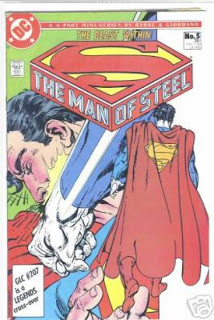 android version that he'll control. Problem is, the basis of the attempt is the theory that Superman is a mutated human. No one, not even Clark, knows that he's an alien at this point. As a result, the android immediately begins to crystalize and becomes Bizarro. This version doesn't speak. He just grunts. He does think he's Clark and Superman, though, so he saves Lois's sister, Lucy, who's a blinded, despairing former stewardess jumping from a balcony. She can't see, of course, and thinks it's Superman, who she's never met. Superman and Bizarro fight, of course, and Clark preserves his secret identity, but Bizarro is blasted into little bits, which somehow react with the chemical that blinded Lucy and restore her sight. Our homage to the past for this issue is at the beginning of the issue when Superman has captured a guy in a battle suit that looks just like Lex Luthor's old green and purple get up. It's not Lex but some hapless employee who's now brain damaged by the suit.
android version that he'll control. Problem is, the basis of the attempt is the theory that Superman is a mutated human. No one, not even Clark, knows that he's an alien at this point. As a result, the android immediately begins to crystalize and becomes Bizarro. This version doesn't speak. He just grunts. He does think he's Clark and Superman, though, so he saves Lois's sister, Lucy, who's a blinded, despairing former stewardess jumping from a balcony. She can't see, of course, and thinks it's Superman, who she's never met. Superman and Bizarro fight, of course, and Clark preserves his secret identity, but Bizarro is blasted into little bits, which somehow react with the chemical that blinded Lucy and restore her sight. Our homage to the past for this issue is at the beginning of the issue when Superman has captured a guy in a battle suit that looks just like Lex Luthor's old green and purple get up. It's not Lex but some hapless employee who's now brain damaged by the suit.
 android version that he'll control. Problem is, the basis of the attempt is the theory that Superman is a mutated human. No one, not even Clark, knows that he's an alien at this point. As a result, the android immediately begins to crystalize and becomes Bizarro. This version doesn't speak. He just grunts. He does think he's Clark and Superman, though, so he saves Lois's sister, Lucy, who's a blinded, despairing former stewardess jumping from a balcony. She can't see, of course, and thinks it's Superman, who she's never met. Superman and Bizarro fight, of course, and Clark preserves his secret identity, but Bizarro is blasted into little bits, which somehow react with the chemical that blinded Lucy and restore her sight. Our homage to the past for this issue is at the beginning of the issue when Superman has captured a guy in a battle suit that looks just like Lex Luthor's old green and purple get up. It's not Lex but some hapless employee who's now brain damaged by the suit.
android version that he'll control. Problem is, the basis of the attempt is the theory that Superman is a mutated human. No one, not even Clark, knows that he's an alien at this point. As a result, the android immediately begins to crystalize and becomes Bizarro. This version doesn't speak. He just grunts. He does think he's Clark and Superman, though, so he saves Lois's sister, Lucy, who's a blinded, despairing former stewardess jumping from a balcony. She can't see, of course, and thinks it's Superman, who she's never met. Superman and Bizarro fight, of course, and Clark preserves his secret identity, but Bizarro is blasted into little bits, which somehow react with the chemical that blinded Lucy and restore her sight. Our homage to the past for this issue is at the beginning of the issue when Superman has captured a guy in a battle suit that looks just like Lex Luthor's old green and purple get up. It's not Lex but some hapless employee who's now brain damaged by the suit.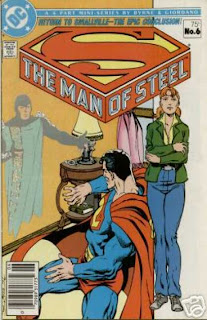 The final issue takes Clark back to Smallville. The rocket ship that brought him to Kansas is now missing. A hologram of Jor-El contacts him and, on touching him, imparts to Clark all the knowledge of Krypton, including several languages, arts, science and so forth. We also have the introduction of Lana Lang, which seems kind of backward, with her not having appeared in the first issue when he was in high school. She's just moved back to Smallville after several years away because of her despair that she'd never marry Clark. See, after his little talk with Pa about the rocket ship and such, Clark went to Lana and told her all. Showed her he could fly, too. Then he took off for parts unknown. Lana was pretty mad and pretty sad. But now she's over it and living in the house in which she grew up, dilapidated though it is. No interesting homage to the past of a visual or cute sort. This one's all about the essence of Superman. Now that he knows he's an alien he still identifies himself as an American and defender of the philosophy of the nation in which he was raised. Rah-rah, sis-boom-bah! I'm a patriot, We The People tattoo and all, but this was really over the top.
The final issue takes Clark back to Smallville. The rocket ship that brought him to Kansas is now missing. A hologram of Jor-El contacts him and, on touching him, imparts to Clark all the knowledge of Krypton, including several languages, arts, science and so forth. We also have the introduction of Lana Lang, which seems kind of backward, with her not having appeared in the first issue when he was in high school. She's just moved back to Smallville after several years away because of her despair that she'd never marry Clark. See, after his little talk with Pa about the rocket ship and such, Clark went to Lana and told her all. Showed her he could fly, too. Then he took off for parts unknown. Lana was pretty mad and pretty sad. But now she's over it and living in the house in which she grew up, dilapidated though it is. No interesting homage to the past of a visual or cute sort. This one's all about the essence of Superman. Now that he knows he's an alien he still identifies himself as an American and defender of the philosophy of the nation in which he was raised. Rah-rah, sis-boom-bah! I'm a patriot, We The People tattoo and all, but this was really over the top.Like I said, this cleaned up the character's past, but it really was the same Superman. It's easy to forget that because of all that happened in later years leading up to Infinite Crisis. The darkness of the DCU that Superboy prime, Alexander Luthor and Superman of Earth-2 deplore isn't there when all this post crisis stuff starts off. Really, even with The Dark Knight Returns setting the stage for that sort of thing, in a non-continuity sort of way, it didn't really develop for awhile. And at first it was just in Batman, where it really made more sense.
I'd really forgotten about how comics were written in these days and before. There's so much exposition, usually in thought balloons that don't represent any way an actual person thinks, or in really stilted soliloquies. I mean, really, you'd think superheroes all had multi-personality disorder, as much as they talked to themselves. And the thought balloons! Long, linear thoughts, just the same as the soliloquies, but internal. No one thinks like that. We tend to think in associations that can go randomly around our ever firing synapses. The only time we think in this kind of linear fashion is if we're writing. Even in speaking we don't tend to think like that. You just don't see much of that in modern comics. Having grown up with that style I don't think I noticed it much then, but it sure stands out now.
Whatever faults there are to my mind now about the writing, the art certainly has held up. I've always liked Byrne's style. He's one of the few to draw people with distinct body shapes. Not everyone comes out of central casting. Body's aside, his ability to draw individual faces is also notable. There's the Byrne style throughout that gives a certain feel to it, but each person has his or her own face. One thing I would say about his art is that there don't seem to be many people who aren't white in Metropolis. Even the South American terrorists look like they're from Spain rather than Venezuela. If they didn't speak in Spanish occasionally, I'd have never guessed they were supposed to be South American. Well, that and Lex saying they were from Venezuela. Not that this is so much a fault of Byrne as the era. Unless a story was specifically centered around a non-white group, most background characters were white in comics, even in 1986.
The only egregious aspect of the series? On the first issue, above the title, there's a banner that says "The Comics Event of the Century!" Really? Not the creation of Superman in 1939, which was the same century? Hell, we just came off of Crisis, which totally re-vamped the DCU. Even that has a better bid at Event of the Century than this. It's a good story and an excellent kick-off of Superman after Crisis, but it's not even close to being the Event of the Century, even within the DCU. Funny thing is, if it appeared on a Marvel Comic, I probably wouldn't have paid any mind. Stan Lee's hyperbole infected all the Marvel covers in my mind and were just to be ignored.
The one big omission? No mention of Kryptonite. Coming out of this, Superman appears to have no weakness at all. I'd think an issue about Kryptonite would take precedence over the more or less filler of issue five's Bizarro/Lucy story.
DC also put out a couple other mini-series to flesh out the Superman history, like World of Smallville, but I only picked up the World of Krypton and that was it. There were about 4 of them, all written by Byrne. After World of Krypton, I don't think I missed anything in not getting the others. I think I sold World of Krypton some time ago.
No comments:
Post a Comment